Where does my drinking water come from?
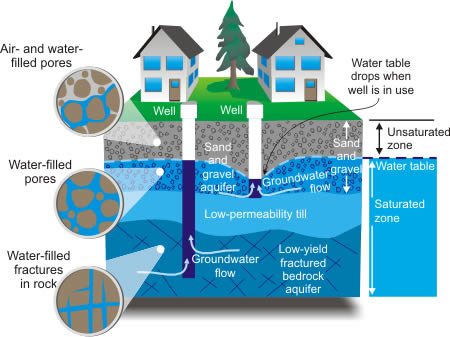 This is a question we hear and answer every day. To keep it simple, there are two main geologic units that we extract our groundwater from: (1) overburden (sand and gravel) deposits, and (2) bedrock. Wells in sand and gravel deposits are typically shallow (less than 40 feet) and maybe referred to as dug wells, point wells, spring wells and screened wells. Groundwater flows through the spaces (pore space) in the sand and gravel materials and into the well. For bedrock wells water flows through the fractures/cracks in the rock and into the open borehole of the well. The above schematic shows the difference of where water originates from and how it gets to the well. For any well, you must have saturated zone below the water table from which water is extracted. When you turn your pump on, the water level drops. The depth to which the water level drops is dependent on the amount of water you are pumping and the recharge capacity (the ability of water to flow through) of the surrounding geologic material.
This is a question we hear and answer every day. To keep it simple, there are two main geologic units that we extract our groundwater from: (1) overburden (sand and gravel) deposits, and (2) bedrock. Wells in sand and gravel deposits are typically shallow (less than 40 feet) and maybe referred to as dug wells, point wells, spring wells and screened wells. Groundwater flows through the spaces (pore space) in the sand and gravel materials and into the well. For bedrock wells water flows through the fractures/cracks in the rock and into the open borehole of the well. The above schematic shows the difference of where water originates from and how it gets to the well. For any well, you must have saturated zone below the water table from which water is extracted. When you turn your pump on, the water level drops. The depth to which the water level drops is dependent on the amount of water you are pumping and the recharge capacity (the ability of water to flow through) of the surrounding geologic material.
Whichever type of well is your water source, knowing the amount of water that you can extract (well yield) is very important. A good rule of thumb is to be able to pump 3-5 gallons per minute (gpm) over a 4 hour period. And to have the water level in the well recover to the pre-pumping within 2 hours so that you can repeat the 4 hours pumping period. However, demands of each household is different dependent on the number of persons in the home and the amount of outdoor water use.


 Our Services Include:
Our Services Include: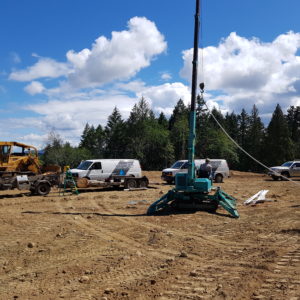
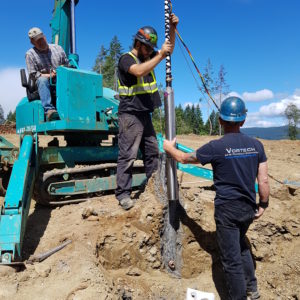
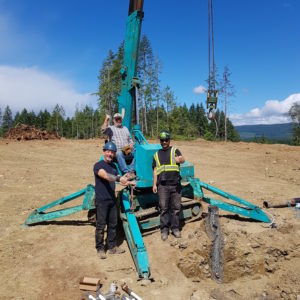
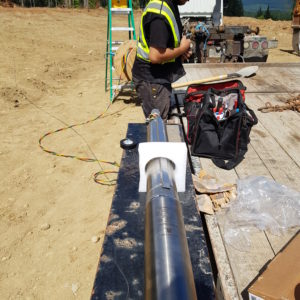
 This is a question we hear and answer every day. To keep it simple, there are two main geologic units that we extract our groundwater from: (1) overburden (sand and gravel) deposits, and (2) bedrock. Wells in sand and gravel deposits are typically shallow (less than 40 feet) and maybe referred to as dug wells, point wells, spring wells and screened wells. Groundwater flows through the spaces (pore space) in the sand and gravel materials and into the well. For bedrock wells water flows through the fractures/cracks in the rock and into the open borehole of the well. The above schematic shows the difference of where water originates from and how it gets to the well. For any well, you must have saturated zone below the water table from which water is extracted. When you turn your pump on, the water level drops. The depth to which the water level drops is dependent on the amount of water you are pumping and the recharge capacity (the ability of water to flow through) of the surrounding geologic material.
This is a question we hear and answer every day. To keep it simple, there are two main geologic units that we extract our groundwater from: (1) overburden (sand and gravel) deposits, and (2) bedrock. Wells in sand and gravel deposits are typically shallow (less than 40 feet) and maybe referred to as dug wells, point wells, spring wells and screened wells. Groundwater flows through the spaces (pore space) in the sand and gravel materials and into the well. For bedrock wells water flows through the fractures/cracks in the rock and into the open borehole of the well. The above schematic shows the difference of where water originates from and how it gets to the well. For any well, you must have saturated zone below the water table from which water is extracted. When you turn your pump on, the water level drops. The depth to which the water level drops is dependent on the amount of water you are pumping and the recharge capacity (the ability of water to flow through) of the surrounding geologic material.